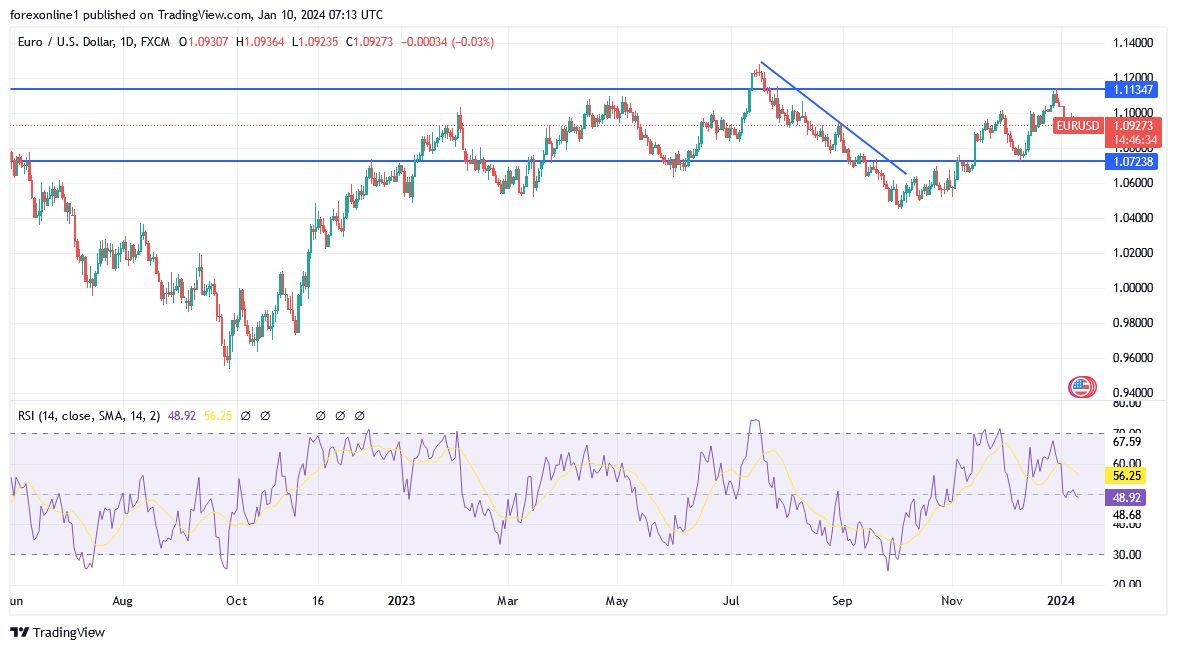The US dollar remains the strongest currency ahead of the release of US inflation figures. As a result, the EUR/USD pair continues to decline, falling to the support level of 1.0910, which is where it is trading around at the time of writing. Substantially, the stronger-than-expected US employment figures provided a lot of positive momentum for the dollar against other major currencies.

What is expected for the euro price in the coming months?
In this regard, Forex currency analysts at MUFG Bank expect the euro/dollar (EUR/USD) exchange rate to rise to the 1.14 resistance at the end of 2024. From a short-term point of view, MUFG expects the EUR/USD pair to reach 1.08. At the end of the first quarter, other banks are less confident in the ability of the EUR/USD pair to advance in the short term. For example, Scotiabank sees a risk that the EUR/USD will fall below 1.0700. From a longer-term perspective, Morgan Stanley has abandoned its bullish stance on the dollar and is now neutral. Also, it dropped its call for EUR/USD parity. According to the latest Reuters poll, the EUR/USD pair is expected to rise to the 1.12 resistance at the end of 2024 after a 3% increase in 2023.
According to Forex market trading, the EUR/USD pair recorded significant losses to 1.0920 during the week from 1.1035 last week, but found support below 1.0900. Furthermore, the minutes of the US Federal Reserve's December meeting cast doubt on an early cut in US interest rates, but there was talk that the bond sales program could end more quickly than expected.
Meanwhile, ING commented “The emphasis on conditionality seems inconsistent with expectations for a March cut, but openness to exiting the QT period and concerns about the economy point in the other direction,”
Recently, the monthly US employment report was stronger than expected with a non-farm payroll increase of 216,000 for December compared to consensus expectations of 170,000, although November's increase was revised to 173,000 from the previously reported 199,000. Moreover, the household survey did not record any change in the unemployment rate from 3.7%, compared to expectations of a slight increase to 3.8%. Nevertheless, there has been a sharp decline in the participation rate and a significant decline in the number of employees, which is approximately 700,000 people. Finally, average hourly earnings rose 0.4% month over month with an annual increase of 4.1% from 4.0% previously.
Before that, the US ISM index of business confidence in the services sector fell to its lowest level in 7 months at 50.6 from 52.7 previously, compared to expectations of 52.6. sharply, the employment component fell to the lowest reading since July 2020 while price declines declined only slightly during the month. Consequently, the overall employment report is likely to cause significant confusion within the Fed and the central bank will need more data to assess the situation. After the ISM data, markets are still calculating a more than 65% chance of a rate cut at the March meeting while the chances of a May rate cut have increased to more than 90%.
As a result, there were sharp fluctuations in the price of the dollar following the release of the data, as the US currency initially strengthened sharply against the backdrop of the main payrolls figures, before declining after the ISM data and ending with marginal gains during the day, with the EUR/USD pair trading around 1.0940. According to Rabobank, “The release of a stronger-than-expected US Labor report supported the view that Fed policymakers are likely to be more dovish than market prices suggested last month.” So, The US dollar index (DXY) settled around 102.40 from 101.40 at the end of 2023.
Top Forex Brokers
ING Bank added, “We are convinced that the US dollar will decline later this year and assume that anywhere above 104 in the dollar index will be met with some good selling interest in the medium term.” But according to MUFG Bank; “There is room for the US dollar to rebound in the near term given the extent of the Fed rate cuts which are now being priced into the rates market. Added, “The likelihood is that the reversal of monetary tightening will be reasonably synchronized this year with the possibility of several central banks cutting interest rates between March and June, this means that Fed rate cuts are unlikely to cause the dollar to fall sharply”.
According to Scotiabank's technical analysis, “The six-hour chart indicates that the EUR/USD price has developed an approximate head and shoulders top since late December; A break below the neckline at 1.0890 will be active and we target a drop to the mid-1.06 areas.”
Technical analysis of the EUR/USD:
We still see that the downward momentum of the EUR/USD pair is getting stronger as long as it remains stable below the 1.1000 level. As we mentioned before, a move towards the support levels of 1.0880 and 1.0790 will have the strongest momentum for the bears to assert control. Obviously, this may happen if the US inflation numbers are stronger than all expectations, giving the markets the opportunity to bet that the US Central Bank will not be in a rush to reduce interest rates. On the other hand, if the US inflation numbers are weaker than expectations, the EUR/USD may find an opportunity to rebound higher. Over the same period, the resistance levels of 1.1020 and 1.1100 will remain the most important for the bulls to control again.
Ready to trade our daily Forex analysis? We’ve made a list of the best forex trading accounts worth trading with.

